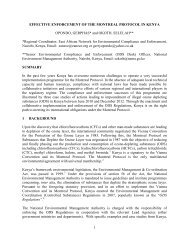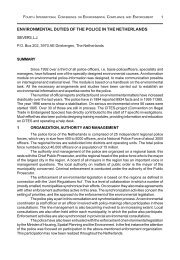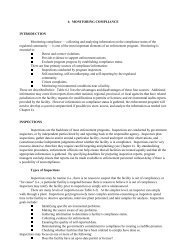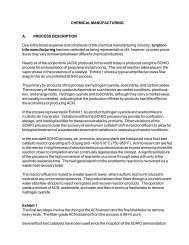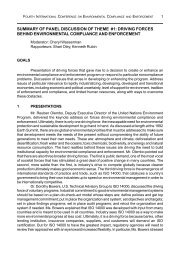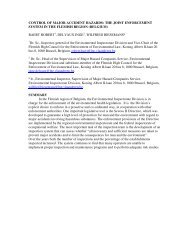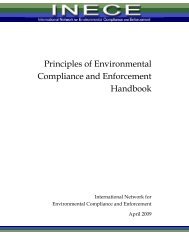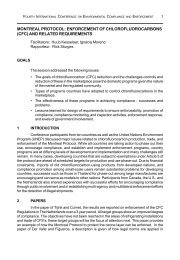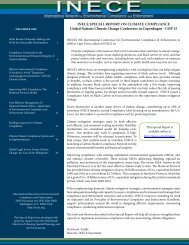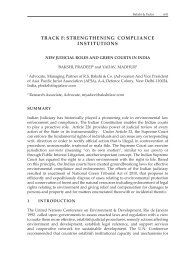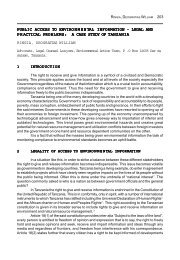Laboratory Analysis Of Catalytic Converters Leads To Better - Inece
Laboratory Analysis Of Catalytic Converters Leads To Better - Inece
Laboratory Analysis Of Catalytic Converters Leads To Better - Inece
You also want an ePaper? Increase the reach of your titles
YUMPU automatically turns print PDFs into web optimized ePapers that Google loves.
LABORATORY ANALYSIS OF CATALYTIC CONVERTERS LEADS TO BETTER<br />
ENFORCEMENT RESULTS<br />
SMITH, DON 1 , SUGGS, JENNIFER 2 , ISIN, AMELIE 3<br />
1 Chemist, National Enforcement Investigations Center, <strong>Of</strong>fice of Criminal Enforcement,<br />
Forensics and Training, <strong>Of</strong>fice of Enforcement and Compliance Assurance, U.S. Environmental<br />
Protection Agency, smith.donj@epa.gov<br />
2 Chemist, National Enforcement Investigations Center, <strong>Of</strong>fice of Criminal Enforcement,<br />
Forensics and Training, <strong>Of</strong>fice of Enforcement and Compliance Assurance, U.S. Environmental<br />
Protection Agency, suggs.jennifer@epa.gov<br />
3 Program Analyst, Air Enforcement Division, <strong>Of</strong>fice of Enforcement and Compliance<br />
Assurance, U.S. Environmental Protection Agency, isin.amelie@epa.gov<br />
SUMMARY<br />
EPA’s National Enforcement Investigations Center (NEIC) is a forensic laboratory that<br />
also analyzes catalytic converters to determine the compliance of recreational vehicle and<br />
motorcycle manufacturers with the Clean Air Act. NEIC has developed some innovative<br />
techniques for the measurement of catalyst washcoat loading on motorcycle and recreational<br />
vehicle catalytic converters. The catalytic converters present a challenge because the washcoat is<br />
tightly bound to a metallic substrate and is physically inaccessible. Physical removal of the<br />
washcoat followed by analysis by X-ray fluorescence spectrometry has shown the vast majority<br />
of the sampled catalytic converters to be noncompliant, leading to successful EPA enforcement<br />
actions against recreational vehicle and motorcycle manufacturers and importers.<br />
1 INTRODUCTION AND BACKGROUND<br />
The U.S. Environmental Protection Agency (EPA)’s mission is to protect human health<br />
and the environment, and this includes responsibilities for air emissions from imported vehicles<br />
and engines. The Clean Air Act (CAA) requires imported engines and vehicles to be covered by<br />
an EPA certificate of conformity (COC), demonstrating that they meet emission standards. EPA<br />
takes action when imported goods are not in compliance with the Clean Air Act.<br />
Many of the imported vehicles that have been inspected by EPA are not covered by their<br />
COCs because the catalytic converters have been found to be materially different from the design<br />
specified in the application for the COC. For this reason, EPA concludes that the source vehicles<br />
are uncertified and have been imported in violation of the Clean Air Act. EPA’s Mobile Source<br />
Enforcement Branch has recently been particularly focused on recreational vehicle and<br />
motorcycle cases, given the high rate of noncompliance with CAA requirements in this sector.<br />
<strong>Laboratory</strong> analysis of catalytic converters is critical for EPA enforcement and helps the<br />
EPA focus its limited resources on the products that cause the most environmental harm.<br />
Vehicles and engines with noncompliant catalytic converters emit higher levels of carbon<br />
monoxide, hydrocarbons, and nitrogen oxides that contribute to the formation of ground-level<br />
ozone, or smog. Exposure to even low levels of ozone can cause respiratory problems, and<br />
repeated exposure can aggravate pre-existing respiratory diseases. In addition, air toxics such as<br />
hydrocarbons are known or suspected human carcinogens.<br />
1
Motorcycle and recreational vehicle catalytic converter specifications include the volume<br />
of the catalytic converter, the amount of each catalytic metal present, and the number of pores in<br />
the converter. The most common catalysts used for pollution control contain metals or metal<br />
oxides such as platinum (Pt), palladium (Pd), rhodium (Rh) and vanadium pentoxide (V 2 O 5 ).<br />
These catalysts increase the rate at which the incomplete combustion products of carbon<br />
monoxide, hydrocarbons, and nitrogen oxides are converted to carbon dioxide, water vapor, and<br />
nitrogen. Catalysts provide a reaction site for the molecules and decrease the reaction energy<br />
needed to convert the molecules. These metals are mixed with a carrier, such as aluminum<br />
oxide, and then deposited on a support that can be either ceramic (automotive catalytic<br />
converters) or metal (recreational vehicle or motorcycle catalytic converters). A typical<br />
recreational vehicle or motorcycle exhaust catalytic converter consists of a metallic substrate that<br />
is coated with an active layer of the carrier, or washcoat. In production, washcoat loading is<br />
normally determined by a weight gain procedure.<br />
When EPA began its laboratory analysis of catalytic converters in 2008, the agency<br />
lacked an established procedure for analysis of recreational vehicle or motorcycle exhaust<br />
catalytic converters. EPA refined its sample preparation and X-ray fluorescence spectrometry<br />
(XRF) analysis methodology through trial and error. Refinements simultaneously improved the<br />
accuracy of results and reduced the time necessary to obtain results, improving the effectiveness<br />
of EPA’s enforcement response. This paper provides a detailed description of the laboratory<br />
techniques EPA is using and the enforcement results EPA has achieved for recreational vehicles<br />
and motorcycles based on its catalytic converter analysis work.<br />
2 SAMPLING<br />
EPA has, to date, examined catalytic converters from vehicles and engines that were built<br />
by more than 18 different manufacturers. Samples are obtained through inspections conducted at<br />
retail locations and at U.S. ports. The U.S. Department of Homeland Security’s Bureau of<br />
Customs and Border Protection (CBP) conducts the portside inspections. <strong>Of</strong>ficers identify<br />
shipments with particular focus on companies that have previously violated the Clean Air Act,<br />
and put them on hold for inspection. EPA investigators, working closely with a special team of<br />
CBP officers, then inspect the vehicles and engines. If the vehicles or engines are certified with<br />
a catalytic converter, EPA removes the muffler. The catalytic converter samples are then<br />
removed from the vehicle muffler, but are left uncut in their original sleeve for mailing to EPA’s<br />
National Enforcement Investigations Center (NEIC) under chain of custody for analysis.<br />
3 SAMPLE PREPARATION AND PHYSICAL MEASUREMENTS<br />
NEIC initially assumed that the internal structure of the motorcycle and recreational<br />
vehicle catalytic converters would contain ceramic substrates similar to that of automotive<br />
catalytic converters.<br />
However, examination of the actual mufflers from motorcycle and recreational vehicles<br />
showed they contained a stainless steel honeycomb mesh coated with the washcoat.<br />
Manufacturers produce the honeycomb from corrugated stainless steel rolled into a cylinder and<br />
encased in a steel tube (Figure 1).<br />
2
FIGURE 1. End View of a Recreational Vehicle or Motorcycle <strong>Catalytic</strong> Converter<br />
Because of this unique configuration, NEIC developed two different strategies to remove<br />
the washcoat. NEIC developed the first strategy from a catalytic converter manufacturer that<br />
employed a wash procedure using acid and hydrogen peroxide. In this procedure, large volumes<br />
of solution containing nitric acid and hydrogen peroxide removed the washcoat containing the<br />
precious metals platinum, palladium, and rhodium. The resulting solution was then treated with<br />
hydrochloric acid and evaporated to dryness. After several cycles of treatment, the residue was<br />
heated to 540 degrees Celsius (°C) in a muffle furnace, then ground. NEIC analyzed the ground<br />
material for the precious metal concentrations.<br />
NEIC’s examination of the stainless steel mesh after the acid and peroxide extractions<br />
revealed that a residue of washcoat remained on the honeycomb mesh. Physical manipulation of<br />
this mesh yielded additional material, indicating incomplete removal of the washcoat. This led<br />
NEIC to develop a procedure to physically remove the washcoat from the catalytic converters.<br />
Physical measurements, photographs, and weights were required to ascertain the<br />
specifications for the catalytic converters. Metric calipers and rulers were used to measure the<br />
height and diameter of the stainless steel mesh and outer pipe. These measurements were used to<br />
calculate the area of the mesh monolith and determine the volume of the cylinder. Photographs<br />
of the ends of the mesh were taken for pore count measurement. Initial, periodic, and final<br />
weights of the samples and separate parts of the samples (outer casing, honeycomb mesh, and<br />
washcoat recovered) were recorded during disassembly.<br />
After the initial weight was recorded, NEIC used an angle grinder with a metal cutting<br />
wheel to cut through the outer casing of the catalytic converter (Figure 2).<br />
3
FIGURE 2. Analyst Cutting the Outer Steel Casing of a <strong>Catalytic</strong> Converter<br />
After the initial cut, NEIC removed the outer pipe to expose the stainless steel mesh that<br />
contained the aluminum oxide based washcoat. In many samples, the stainless steel mesh was<br />
manually unwound to remove the washcoat. Unwinding the mesh removed a significant amount<br />
of washcoat material, which was collected, weighed, and stored. The physical removal was<br />
continued until no additional washcoat could be removed.<br />
In some other samples, the fabrication of the honeycomb mesh prevented the mesh from<br />
unwinding. These samples required disassembly with additional force and also additional care to<br />
ensure minimal loss of washcoat.<br />
<strong>To</strong> disassemble these more challenging samples, NEIC placed the tip of an awl into a<br />
mesh hole and tapped it with a rubber mallet to break the mesh and release the washcoat. Using<br />
these tools, the mesh was reduced to small metal pieces. Both washcoat and metal pieces were<br />
collected in weigh boats beneath the samples. A magnet was used to remove metallic fragments<br />
from the powder (Figure 3).<br />
NEIC investigated a coarse disassembly method that separated the mesh into large<br />
chunks instead of small strips. If successful, a coarse disassembly could provide a faster method<br />
of disassembly with the same or similar washcoat removal results. After this coarse method was<br />
applied, weights were obtained, then the large chunks were reduced further using the fine<br />
disassembly method. After the samples were completely reduced using the fine disassembly,<br />
weights for the mesh pieces and for the washcoat were taken. A comparison of the weights<br />
indicated that a significant amount of washcoat still remained in the mesh after the coarse<br />
disassembly method. The more intensive and time-consuming fine disassembly proved to be the<br />
better method for removal of the washcoat.<br />
4
FIGURE 3. Removal of Metallic Debris Using a Magnet<br />
4 XRF ANALYSIS<br />
NEIC selected XRF to analyze the precious metal content of the catalytic converter<br />
washcoat. This technique uses an X-ray source to remove inner shell electrons of the atoms in a<br />
sample which in turn are replaced by outer shell electrons. The resulting change in energy<br />
causes the atoms to emit X-rays that are characteristic of that element. The emitted X-rays are<br />
measured quantitatively by calibrating the instrument with standards containing known<br />
concentrations of the elements of interest. XRF was chosen because it is relatively fast, has very<br />
high precision, and does not require dissolution of the sample. However, since XRF is a direct<br />
measurement analytical tool, sample preparation is critical. The success of the technique<br />
depends on how similar the samples are to the calibration standards, both in physical form and in<br />
chemical makeup.<br />
Washcoat removal frequently yields masses that are too low to utilize standard XRF<br />
pressed powder sample preparation techniques. <strong>To</strong> provide a consistent, stable sample for XRF<br />
analysis, the samples are diluted in reagent grade aluminum oxide and a cellulose binder. This<br />
mixture of washcoat, aluminum oxide, and cellulose binder is ground with an agate mortar and<br />
pestle or using a ball mill and then pressed into a pellet that can be analyzed by XRF. The XRF<br />
spectrometer is calibrated using a combination of National Institute of Standards and Technology<br />
(NIST) standard reference materials (SRMs) and synthetically prepared standards containing<br />
platinum, palladium, and rhodium. Variations in the sample matrix are partially corrected<br />
through the use of a Compton scattering correction.<br />
5
5 RESULTS<br />
EPA’s enforcement efforts are constantly evolving to keep pace with the changing<br />
compliance landscape. Currently, EPA is addressing the growing number of recreational vehicle<br />
and motorcycle imports from China. <strong>To</strong> date, almost all of the catalytic converters sampled from<br />
these vehicles and sent to the laboratory for analysis have been found to be noncompliant. This<br />
may, in part, be due to the rising costs of the precious metals which are critical to catalytic<br />
converter efficacy.<br />
In 2010, EPA and CBP stopped a total of about 14,000 recreational vehicles, small<br />
gasoline-powered engines, and motorcycles at the port because they were not built to the correct<br />
certified design. In almost all instances, these vehicles and engines bore labels stating they were<br />
certified. EPA inspections, however, found that approximately 80% of the vehicles and engines<br />
differed from the certified design in ways that could affect emissions, with about half of the<br />
uncertified vehicles and engines having nonconforming catalytic converters.<br />
In addition to seizures at the ports, EPA’s inspections and analysis work has culminated<br />
in several case settlements, the largest of which was against The Pep Boys – Manny, Moe & Jack<br />
(Pep Boys) and Baja, Inc. (Baja) in May 2010. Pep Boys is a national automotive aftermarket<br />
and service chain that operates more than 580 stores in 35 states and Puerto Rico. Baja contracts<br />
with manufacturers in the People’s Republic of China to supply recreational vehicles and<br />
motorcycles to Pep Boys and other U.S. companies. Baja also handles all after-sale functions,<br />
such as warranty claims and replacement parts. This case was the largest vehicle and engine<br />
importation case brought under the CAA by the U.S. by number of vehicles and engines affected<br />
and penalty paid. The case involved the importation of at least 241,000 illegal vehicles and<br />
engines over a six year period, and resulted in a $5 million civil penalty. At its peak, Pep Boys<br />
was the third largest importer of Chinese-made all-terrain vehicles in the U.S. All of the<br />
catalytic converters analyzed in support of the Pep Boys case were found to be noncompliant.<br />
In June 2010, EPA settled another imports case against Taotao USA, Inc. (Taotao)<br />
involving noncompliant catalytic converters. Taotao and its predecessor, AIMX Industry, Inc.,<br />
d.b.a./a.k.a. AIM-EX Industry, Inc., or Vicoo Industry, Inc, imported thousands of illegal<br />
recreational vehicles into the U.S. between 2008 and 2010. In addition, Taotao was the largest<br />
importer last year of Chinese-made all-terrain vehicles in the U.S. The settlement required<br />
Taotao to pay a $260,000 penalty and implement a rigorous corporate compliance plan,<br />
including regular catalytic converter testing.<br />
On-road and off-road vehicles and engines emit roughly half of the U.S. air pollution.<br />
Importing vehicles and engines without proper emission controls is not only detrimental to<br />
human health and the environment; it also provides an unfair competitive advantage to the<br />
manufacturers of noncompliant products. <strong>To</strong> address the myriad and expanding number of ways<br />
in which vehicles and engines can be noncompliant, EPA will continue to innovate and explore<br />
new laboratory procedures in support of enforcement cases to ensure that products imported and<br />
sold in the U.S. comply with the Clean Air Act.<br />
6
6 BIBLIOGRAPHY<br />
EPA FACTSHEET: Air <strong>To</strong>xics from Motor Vehicles, U.S. Environmental Protection Agency,<br />
available at http://www.epa.gov/oms/f02004.pdf.<br />
Heck, R. M., Farrauto, R. J., and Gulati, S. T., <strong>Catalytic</strong> Air Pollution Control: Commercial<br />
Technology, 2 nd ed., 2002, pp. 3-24, 69-73.<br />
The Pep Boys Manny, Moe & Jack and Baja, Inc. Settlement, U.S. Environmental Protection<br />
Agency, available at http://epa.gov/compliance/resources/cases/civil/caa/pepboys.html.<br />
US EPA Clean Air Act Mobile Source Importation Settlement Information, U.S. Environmental<br />
Protection Agency, available at http://cfpub.epa.gov/compliance/civil/programs/caa/importation/.<br />
7



